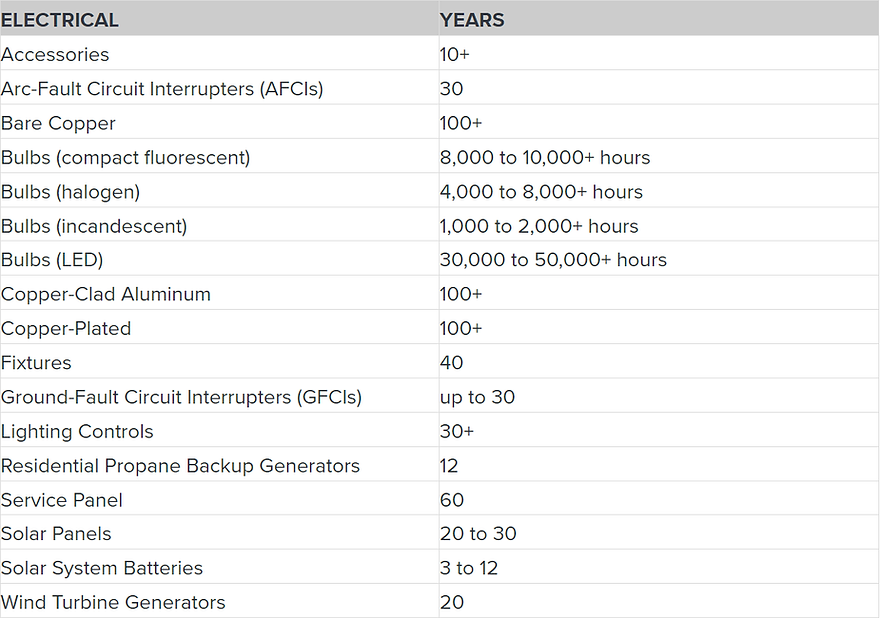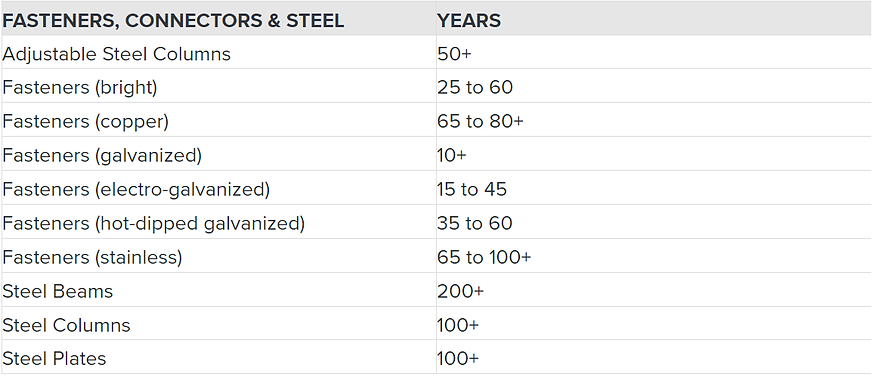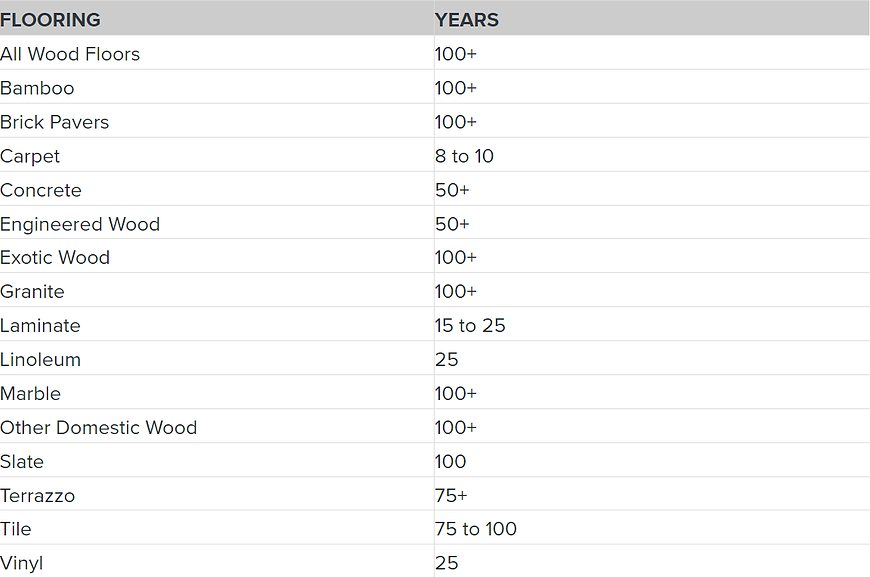Page Title
InterNACHI's Standard Estimated Life Expectancy Chart for Homes

The following chart details the predicted life expectancy of appliances, products, materials, systems and components. (For homes located in Florida and the surrounding coastal region, please refer to InterNACHI's Florida Estimated Life Expectancy Chart for Homes.)

Consumers, inspectors, and professionals advising their clients should note that these life expectancies have been determined through research and testing based on regular recommended maintenance and conditions of normal wear and tear, and not extreme weather or other conditions, neglect, over-use or abuse. Therefore, they should be used as guidelines only, and not relied upon as guarantees or warranties.
Full-color, downloadable version to include with inspection reports.
***********************************************************************

Surface preparation and paint quality are the most important determinants of a paint's life expectancy. Ultraviolet (UV) rays via sunshine can shorten life expectancy. Additionally, conditions of high humidity indoors or outdoors can affect the lifespan of these components, which is why they should be inspected and maintained seasonally.
Appliance life expectancy depends to a great extent on the use it receives. Furthermore, consumers often replace appliances long before they become worn out due to changes in styling, technology and consumer preferences.


Modern kitchens today are larger and more elaborate. Together with the family room, they now form the “great room.”

Walls and ceilings last the full lifespan of the home.
Natural stone countertops, which are less expensive than they were just a few years ago, are becoming more popular, and one can expect them to last a lifetime. Cultured marble countertops have a shorter life expectancy, however.


Decks are exposed to a wide range of conditions in different climates, from wind and hail in some areas, to relatively consistent, dry weather in others. See FASTENERS & STEEL section for fasteners.
Exterior fiberglass, steel and wood doors will last as long as the house, while vinyl and screen doors have a shorter life expectancy. The gaskets/weatherstripping of exterior doors may have to be replaced every five to eight years.

Copper-plated wiring, copper-clad aluminum, and bare copper wiring are expected to last a lifetime, whereas electrical accessories and lighting controls, such as dimmer switches, may need to be replaced after 10 years. GFCIs could last 30 years, but much less if tripped regularly.
Remember that faulty, damaged or overloaded electrical circuits or equipment are the leading cause of house fires, so they should be inspected regularly and repaired or updated as needed.


Floor and roof trusses and laminated strand lumber are durable household components, and engineered trim may last 30 years.
Fastener manufacturers do not give lifespans for their products because they vary too much based on where the fasteners are installed in a home, the materials in which they're installed, and the local climate and environment. However, inspectors can use the guidelines below to make educated judgments about the materials they inspect.


Flooring life is dependent on maintenance and the amount of foot traffic the floor endures.
Concrete and poured-block footings and foundations will last a lifetime, assuming they were properly built. Waterproofing with bituminous coating lasts 10 years, but if it cracks, it is immediately damaged.

Framing and structural systems have extended longevities; poured-concrete systems, timber-frame houses, and structural insulated panels will all last a lifetime.

Framing and structural systems have extended longevities; poured-concrete systems, timber-frame houses, and structural insulated panels will all last a lifetime.

The quality and frequency of use will affect the longevity of garage doors and openers.

Home technology systems have diverse life expectancies and may have to be upgraded due to evolution in technology.
Thermostats may last 35 years but they are usually replaced before they fail due to technological improvements.

* Batteries should be changed at least annually.
As long as they are not punctured, cut or burned and are kept dry and away from UV rays, cellulose, fiberglass and foam insulation materials will last a lifetime. This is true regardless of whether they were installed as loose-fill, housewrap, or batts/rolls.


Masonry is one of the most enduring household components. Fireplaces, chimneys and brick veneers can last the lifetime of the home.

Custom millwork and stair parts will last a lifetime and are typically only upgraded for aesthetic reasons.

The lifetime of any wood product depends heavily on moisture intrusion.
The quality of plumbing fixtures varies dramatically. The mineral content of water can shorten the life expectancy of water heaters and clog showerheads. Also, some finishes may require special maintenance with approved cleaning agents per the manufacturers in order to last their expected service life.


Radon mitigation systems have but one moving part: the radon fan.
The life of a roof depends on local weather conditions, building and design, material quality, and adequate maintenance. Hot climates drastically reduce asphalt shingle life. Roofs in areas that experience severe weather, such as hail, tornadoes and/or hurricanes, may also experience a shorter-than-normal lifespan overall, or may incur isolated damage that requires repair in order to ensure the service life of the surrounding roofing materials.

Exterior siding materials typically last a lifetime. Some exterior components may require protection through appropriate paints or sealants, as well as regular maintenance. Also, while well-maintained and undamaged flashing can last a long time, it is their connections that tend to fail, so seasonal inspection and maintenance are strongly recommended.


Site and landscaping elements have life expectancies that vary dramatically.

Swimming pools are composed of many systems and components, all with varying life expectancies.

Aluminum windows are expected to last between 15 and 20 years, while wooden windows should last nearly 30 years.
Note: Life expectancy varies with usage, weather, installation, maintenance, and quality of materials. This list should be used only as a general guideline and not as a guarantee or warranty regarding the performance or life expectancy of any appliance, product, system or component.

Information on this page was provided by InterNACHI® at https://www.nachi.org/life-expectancy.htm